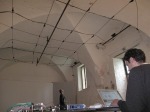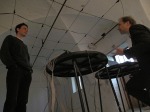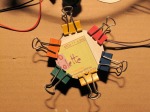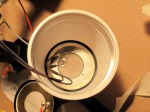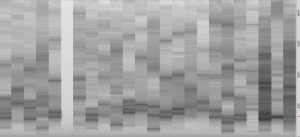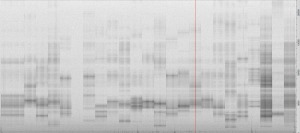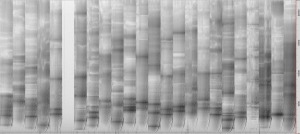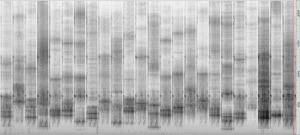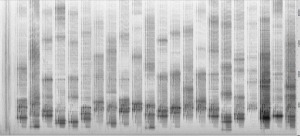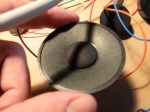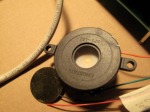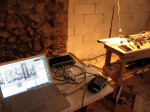Liki version 5
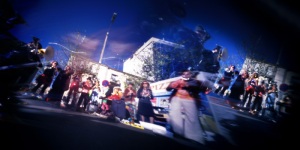 Movement exists if one references it.
Movement exists if one references it.I stop and the present passes on.
This is not an escape, as I do not look at the past, I am only interested in the path ahead and what will make me live.
Liki, the 2009 creation of the PulX collective, will receive a good blow of varnish before embarking you on its journey…
Residency from November 29 till December 10
Show on December 9 and 10, at 7 pm, in The Chapel Gely (Figuerolles, Montpelier, France)
Here are some excerpts:
Filed under: Works | Leave a Comment
梅香堂の小さな音(S0UNDB1TS at Baikado)
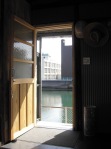 A small version of the s0undb1ts system travels to Osaka. Jean-Philippe presents a sound installation at Baikado from December 19, 2009 to January 11, 2010. The installation features 24 piezo speakers and a microphone for a lively s0undb1ts experience. The sound composition derives from the Liki project by Pulx and is carefully adapted to the environment.
A small version of the s0undb1ts system travels to Osaka. Jean-Philippe presents a sound installation at Baikado from December 19, 2009 to January 11, 2010. The installation features 24 piezo speakers and a microphone for a lively s0undb1ts experience. The sound composition derives from the Liki project by Pulx and is carefully adapted to the environment.
| an excerpt | |
| an other one |
Filed under: Works | Leave a Comment
Liki in Berlin
Pulx is now playing Liki, its new performance associating dance, photographs, and music. After o espaço do tempo in Montemor-O-Novo (Portugal) and Uzès danse (France) in June, Pulx will present Liki in Berlin very soon: the 26 August 2009, (8 pm) at the Podewil theatre, for the Tanz im August festival. A body, pictures, s0undb1ts and sounds for a travel of 30 minutes.
Filed under: Works | Leave a Comment
SOUNDB1TS on the Road
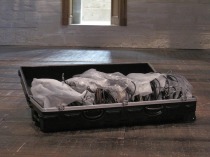 After having finished all 16 s0undb1ts webs at Barjols, Pulx moved on to La Chartreuse de Villeneuve lez Avignon with two flight cases each of which contains 8 webs of 6 x 4 speakers (2 x 8 x 6 x 4 = 16 x 24 = 384).
After having finished all 16 s0undb1ts webs at Barjols, Pulx moved on to La Chartreuse de Villeneuve lez Avignon with two flight cases each of which contains 8 webs of 6 x 4 speakers (2 x 8 x 6 x 4 = 16 x 24 = 384).
At La Chartreuse, for the first time s0undbits has been installed in a theatre. The webs have been spanned out under the ceiling just below the lights.
Little by little, the sound gets organized in space and time. Here is an ORTF recording of some current ideas:
Filed under: Works | Leave a Comment
S0UNDB1TS goes FTM & Co
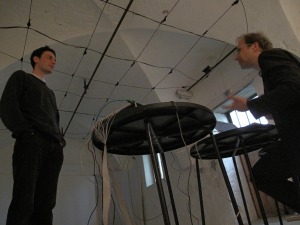 After so many years, s0undb1ts finally became a new software that this time is based on FTM & Co for Max/MSP. Norbert joined Pulx over Easter at La Tannerie to discuss some sound ideas for Pulx’ new show Liki and to write some custom Max/MSP modules to drive s0undb1ts.
After so many years, s0undb1ts finally became a new software that this time is based on FTM & Co for Max/MSP. Norbert joined Pulx over Easter at La Tannerie to discuss some sound ideas for Pulx’ new show Liki and to write some custom Max/MSP modules to drive s0undb1ts.
The new s0undb1ts specific software is an extension of the FTM & Co Gabor library by a special s0undb1ts overlap-add module (actually overlap-bitwise-xor) allowing the assignment of each sound grain to one of the 1-bit outputs. Now, s0undb1ts sound and structure generators can be written using FTM & Co and the granular synthesis paradigms provided by Gabor.
After having discovered and further studied the amazing efficiency of particular sounds produced by birds, Norbert started to experiment with sweep generators. As a result of these experiments we managed to reproduce the essence of the gestalt of these bird sounds with pitch and timbre modulated 1-bit grains. An ad-hoc recording of a test run with the fist 48-s0undb1Its prototype installation has been uploaded here:
The rhythm of the sweeps in this example are generated by random generators using customized probability density functions.
The sweeps add a further set of timbres to the s0undb1ts sound palette (joining all kinds of noise, clicks and buzzes).
For controlling the assignment of sounds to the speaker matrix in real-time with a graphic tablet, Jean-Philippe uses an FTM & Co k-nearest neighbor (KNN) module, mnm.knn. This method allows for the flexible setup of the actual matrix geometry and multiple subsets of speakers (above stage and audience, different types of piezos, etc.).
Filed under: R&D | Leave a Comment
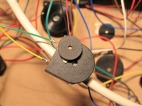 Last time we tested 24 different piezo speakers. Here we compare in more detail some of the piezos that seem t be particularly interesting and experiment with combinations of piezos as well as with simple resonators.
Last time we tested 24 different piezo speakers. Here we compare in more detail some of the piezos that seem t be particularly interesting and experiment with combinations of piezos as well as with simple resonators.
- #4 is made of two plates (push-pull) producing some low frequencies (300 Hz) at a decent level
- #18 is the most flat and is a good complement to #4
- #16 is sharp and tiny, and a good complement to #18
- #24 is the original with a membrane
The recordings are all in the following sequence: #24, #18, #24, #18 + #16, #24, #4, #24, #18 + #16 + #4, 24.
| Listen to the birds the clicks the white noise and the sweeps. | clicks white noise and sweeps. |
Filed under: R&D | Leave a Comment
A S0UNDB1TS Web
The s0undb1ts theater installation Jean-Philippe is currently working on, will be spanned over the stage and the audience. Here are elements of the web (each for 6×4 loudspeakers) that can be joined to a matrix of variable size. For small venues, the resolution can be doubled by superposing two matrices. Here are the first images of the web elements.
Filed under: R&D | Leave a Comment
Mesclun de Piezos
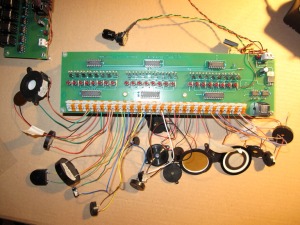 With Pulx in residence at La Tannerie in Barjols in the south of France, Jean-Philippe is testing different piezo speakers. How do they react to different (s0undb1tted) sounds?
With Pulx in residence at La Tannerie in Barjols in the south of France, Jean-Philippe is testing different piezo speakers. How do they react to different (s0undb1tted) sounds?
The sounds and spectrograms below correspond to a series of of 1-bit test sounds played through different piezos and recorded from about 1m.
Each sound is played successively through 24 different speakers (not always starting from the first, the 6th missing sometimes, but always counting to 24).
Filed under: R&D | Leave a Comment
S0UNDB1TS Resurrection
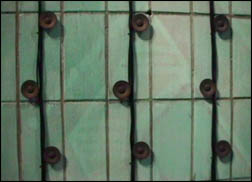 The S0UNDB1TS dispositif provides hundreds of independent elementary 1-bit audio channels.
The S0UNDB1TS dispositif provides hundreds of independent elementary 1-bit audio channels.
S0UNDB1TS was originally created in 2002 at IRCAM for a sound installation project by Robin Minard at the Inventionen festival in Berlin.
Sound installations based on S0UNDB1TS have been shown in Berlin, Paris and Geneva.
Finally, beginning of 2009, after many years of silence we are getting back to this project driven by Jean-Philippe Lambert and Roland Cahen.
The plan is to first update the S0UNDB1TS software to Max/MSP and to revise the hardware before heading out for new S0UNDB1TS adventures…
Filed under: About | Leave a Comment




